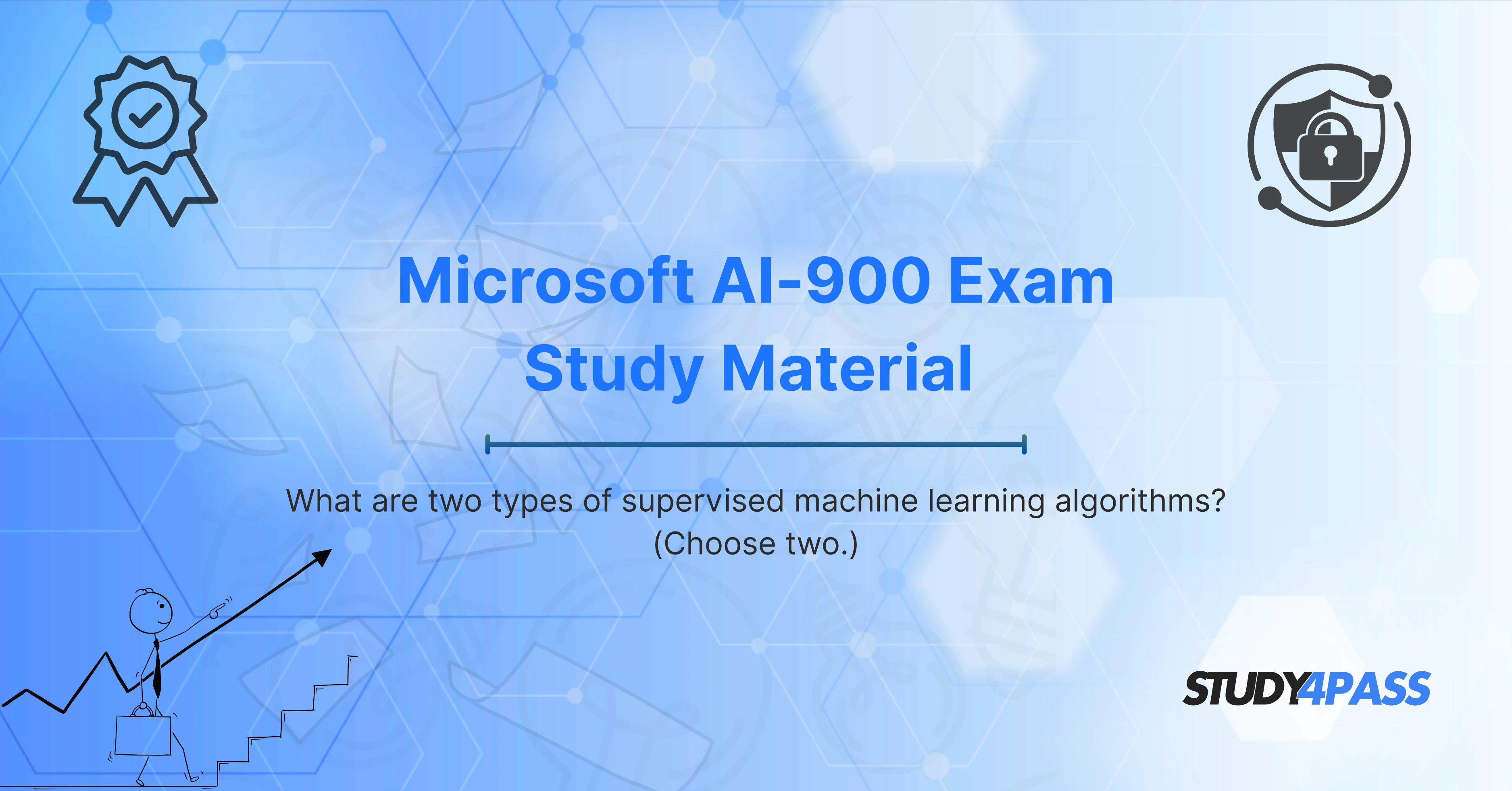Introduction
Supervised machine learning is a fundamental concept in artificial intelligence (AI) and a key topic in the Microsoft Azure AI-900 certification exam. This learning approach involves training a model using labelled data, where the algorithm learns from input-output pairs to make predictions on unseen data.
In this article, we will explore two primary types of supervised machine learning algorithms:
- Classification
- Regression
We will also discuss their applications, differences, and relevance in Microsoft Azure AI services. Additionally, we recommend Study4Pass as an excellent resource for AI-900 exam preparation, offering high-quality study materials, practice tests, and expert guidance.
Classification Algorithms
Definition
Classification is a supervised learning technique where the model predicts discrete categories or labels for input data. It assigns inputs to one of several predefined classes.
Key Characteristics
- Output is a class label (e.g., "spam" or "not spam").
- Used when the target variable is categorical.
- Common algorithms include:
- Logistic Regression (despite its name, it's used for classification)
- Decision Trees
- Random Forest
- Support Vector Machines (SVM)
- Naïve Bayes
Real-World Applications
- Email Spam Detection – Classifies emails as "spam" or "not spam."
- Medical Diagnosis – Predicts whether a patient has a disease (e.g., "cancer" or "no cancer").
- Sentiment Analysis – Determines if a review is "positive," "negative," or "neutral."
- Image Recognition – Identifies objects in images (e.g., "cat," "dog," "car").
Example in Microsoft Azure
Azure offers Azure Machine Learning (AML) with built-in classification algorithms. For instance:
- Automated ML in Azure can train classification models without extensive coding.
- Azure Cognitive Services provides pre-trained models for text and image classification.
Regression Algorithms
Definition
Regression is a supervised learning method used to predict continuous numerical values instead of discrete classes. It establishes a relationship between dependent and independent variables.
Key Characteristics
- Output is a numeric value (e.g., price, temperature, sales).
- Used when the target variable is continuous.
- Common algorithms include:
- Linear Regression
- Polynomial Regression
- Ridge & Lasso Regression
- Decision Trees (for regression tasks)
Real-World Applications
- House Price Prediction – Estimates property values based on features like location and size.
- Stock Market Forecasting – Predicts future stock prices.
- Weather Prediction – Forecasts temperature or rainfall.
- Sales Forecasting – Predicts future sales based on historical trends.
Example in Microsoft Azure
Azure provides tools like:
- Azure Machine Learning Studio for building regression models.
- Azure Databricks for large-scale regression analysis.
Classification vs. Regression: Key Differences
|
Feature |
Classification |
Regression |
|
Output Type |
Categorical (discrete labels) |
Continuous (numeric values) |
|
Example Use Case |
Spam detection |
House price prediction |
|
Evaluation Metrics |
Accuracy, Precision, Recall |
RMSE, MAE, R-squared |
|
Algorithms |
Logistic Regression, SVM |
Linear Regression, Decision Trees |
Why These Algorithms Matter for AI-900 Exam?
The Microsoft Azure AI-900 exam tests foundational AI and ML knowledge, including:
- Understanding supervised vs. unsupervised learning.
- Knowing when to use classification vs. regression.
- Familiarity with Azure ML tools for these tasks.
Mastering these concepts ensures success in the exam and practical AI implementations.
Study4Pass: Your Best AI-900 Exam Preparation Partner
Preparing for the Microsoft Certified: Azure AI Fundamentals (AI-900) exam requires structured learning and practice. Study4Pass offers:
- Comprehensive Study Guides – Covers all AI-900 topics in detail.
- Practice Tests – Simulates real exam scenarios with detailed explanations.
- Expert Tips – Helps avoid common mistakes and improve scores.
- Up-to-Date Content – Aligns with the latest Microsoft exam objectives.
By using Study4Pass, you gain confidence and knowledge to pass the AI-900 exam on your first attempt.
Conclusion
Understanding classification and regression is crucial for anyone pursuing a career in AI and machine learning, especially for the Microsoft Azure AI-900 certification. These supervised learning techniques form the backbone of predictive modeling in real-world applications.
For the best exam preparation, leverage Study4Pass to access high-quality study materials, practice tests, and expert guidance. Start your journey toward becoming a Microsoft Certified: Azure AI Fundamentals professional today!
Special Discount: Offer Valid For Limited Time “AI-900 Exam Material”
Actual Exam Question From Microsoft's AI-900 Exam.
Sample Questions For Microsoft AI-900 Practice Exam
1. What are two types of supervised machine learning algorithms? (Choose two.)
A) Clustering
B) Regression
C) Dimensionality Reduction
D) Classification
2. Which of the following are supervised learning algorithms? (Select two.)
A) K-Means
B) Decision Trees
C) Principal Component Analysis (PCA)
D) Logistic Regression
3. Supervised learning includes which of the following types? (Choose two.)
A) Reinforcement Learning
B) Classification
C) Association Rule Learning
D) Linear Regression
4. Which two algorithms fall under supervised learning? (Select two.)
A) Random Forest
B) K-Nearest Neighbors (KNN)
C) Apriori
D) Support Vector Machine (SVM)
5. Identify two supervised machine learning techniques. (Choose two.)
A) Anomaly Detection
B) Naive Bayes
C) Hierarchical Clustering
D) Polynomial Regression


